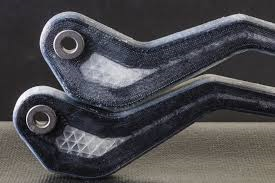Lightweight and Strong Materials used in Product Manufacturing or Composites are light in weight, compared to most woods and metals. Their lightness is important in automobiles and aircraft, for example, where less weight means better fuel efficiency (more miles to the gallon). People who design airplanes are greatly concerned with weight, since reducing a craft’s weight reduces the amount of fuel it needs and increases the speeds it can reach. Some modern airplanes are built with more composites than metal including the new passenger planes.
“Below we have listed four composite materials that offer light weight, durability and high strength”.
Carbon-Reinforced Nylon
Carbon has the highest strength to weight as well as the highest thermal conductivity. Works well with products requiring great strength.
Kevlar-Reinforced Nylon
Kevlar has the best abrasion resistance and is the most flexible reinforced nylon material. Kevlar-Reinforced Nylon works well when you need parts that are durable and resistant to impact.
Fiberglass-Reinforced Nylon
Fiberglass has the lowest cost of the reinforced Nylon materials. It’s as strong as Carbon Fiber, but 60% less stiff, and 2X heavier. Suited to everyday applications where you need strong parts and weight is not a major concern.
HSSS / High Specific Strength Steel or Steel Alloy
this new steel is created by allying the steel with aluminum — this lightens the steel, but also makes it weak and therefore a dash of manganese and a sprinkle of nickel is added, while modifying the way the metal crystals form at the nanometer scale. High Specific Strength Steel has an even better strength-to-weight ratio than the far more expensive titanium.
A message from the president and owner of the company:
“I’m here to assist inventors, companies and organizations with their prototyping design, development and manufacturing services.
Thanks for taking the time to view this prototyping design, development and product manufacturing website and I look forward to hearing from you,
Anthony”.
